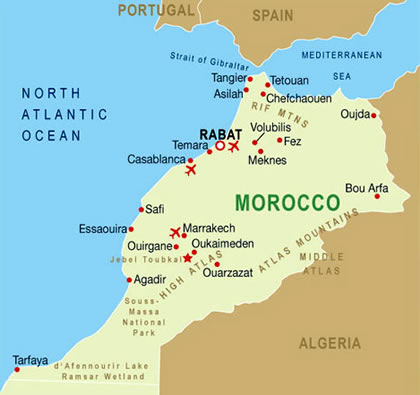 |
| Map of Morocco |
Following the establishment of the French protectorate over Morocco in 1912, numerous nationalist movements emerged; after World War II these parties, especially the Istiqlal (Independence) led by Allal al-Yusuf, mobilized opposition to the French regime. There was also a small urban-based Communist Party led Mehdi Ben Barka.
The Sultan Muhammad Ben Yusuf, the king of the old Alaouite dynasty, supported the nationalist demands. In 1947 he gave a rousing speech in the international city of Tangier in which he pointedly did not declare his loyalty to the French. This was seen as support for the nationalist cause and was a turning point in the struggle.
After riots broke out in the major port city of Casablanca, the French promptly appointed a hard-line military man to restore order. As discontent continued to escalate, the sultan demanded the establishment of his own government. In 1953 the French sent Muhammad into exile, but he did not abdicate.
The French attempted to install the highly unpopular Muhammad Ben Arafa, a prince of the Glawi house, as their puppet ruler, but he barely escaped an assassination attempt by Moroccan nationalists. Violence increased, and Arafa fled. Faced with mounting violence and an ongoing war in Algeria, the French granted Morocco independence in 1956. Muhammad returned to become King Muhammad V in 1957.
Morocco gradually reasserted its authority over Spanish-held territory in the north but the Spanish retained control over a small enclave and several offshore islands that they hold until the present day. In 1959 Tangier lost its special status and was integrated into Morocco as a free port.
Although the Istiqlal remained a key force in the Cabinet, Muhammad V had widespread governmental authority and enjoyed popular support as well as religious respect based on baraka, or good fortune. After his death in 1962, his son succeeded as King Hassan II.
Hassan instituted a new constitution in 1962 but continued to exercise wide executive powers. The Istiqlal split in 1959, and a new group, the Union Nationale des Forces Populaire (UNFP), supported by Ben Barka, emerged. Following increased political opposition, Hassan proclaimed a state of emergency with full legislative and executive powers in 1965.
Ben Barka went into exile in France, where he was kidnapped and presumably killed with the complicity of the Moroccan government in 1965. Political demonstrations against the regime continued in major cities throughout Morocco in the late 1960s, but Hassan remained in power owing to a combination of loyal courtiers, army officers, and security police.
In 1971 armed cadets stormed the royal palace during Hassan’s birthday party, but when they failed to kill the king the attempted coup collapsed. In 1972 Hassan survived an airplane attack orchestrated by the formerly loyal general Mohammad Oufkir. The coup plotters, including Oufkir, were killed or imprisoned. In spite of ongoing charges of corruption and nepotism, Hassan remained in power.
Economically, Morocco was predominately an agricultural country but phosphates were its primary export and source of hard currency. Tourism was another major source of income. With a growing young population, Morocco, like many poor countries in the global south, found it increasingly difficult to provide adequate education or jobs for its youth.
Many attempted to flee the poverty of the countryside by moving to the cities, where they joined the ranks of the unemployed, or by traveling to Europe as migrant workers. In the 1990s and afterward, these disaffected youth often sympathized with or joined Islamist movements.
In 1975 Hassan claimed the territory of the Western Sahara, formerly held by Spain, as part of Morocco and launched the so-called “Green March” of hundreds of thousands of Moroccans to take the territory. An ongoing war ensued; although the United Nations demanded a referendum to settle the issue, Morocco has consistently delayed the election and the matter remains unresolved until the present day.
Although Morocco has had some success in furthering education and welfare projects and modernizing its economy, wide disparities between urban and rural areas and differing population and tribal groups remain. Following Hassan’s death in 1999, his oldest son succeeded as King Mohammed VI.
Well educated, Mohammed VI was keen to modernize the country; he also liberalized the political system, releasing many political prisoners from his father’s regime. In 2004 he also instituted a new family code to grant women more power.
Islamists, many of whom opposed Morocco’s close ties with the West and the modernizing programs, remained the major opponents to King Muhammad VI’s regime.

EmoticonEmoticon